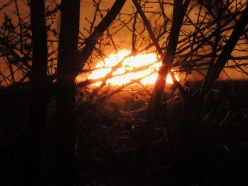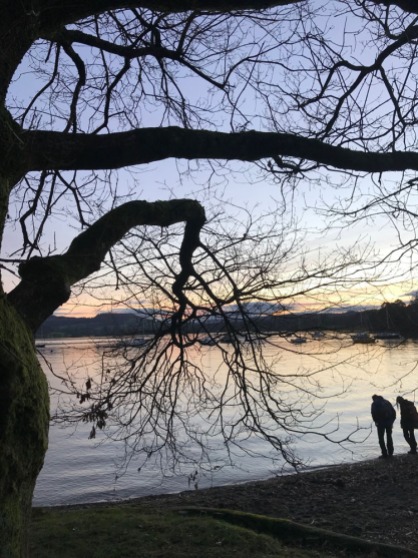
We often hear the phrase, ‘there’s always light and dark’: two things that stand in polarity – opposition, even – but do we ever stop to let the mind and emotions lead us to a deeper realisation?
Light may be mysterious but it’s a clearly identified ‘thing’ – though it doesn’t have edges. We will see, later, why this is important.
We can flick a switch and have light flow, just like water from a tap.
But which switch do we flick to turn on darkness?
The brain’s cogs begin to twitch suspiciously at this point, as we are brought closer to the semi-intuitive relationship between the light we can turn on and the ‘not-light’ we can’t.
Can we investigate the nature of dark more deeply?
Darkness would appear to be the ‘absence of light’? I can’t turn on dark, but I can engineer a situation where all the light is removed, such as a room at night in which I close the curtains and switch off the lights.
Instant darkness…and I’ve ’created’ it, but not with a positive action. My action was to completely remove a positive thing, leaving the negative not-thing behind.
We can appreciate darkness with our senses. The lack of light makes our pupils dilate, and our mind hunts familiar outlines in the gloom; prompted by the insistent hard-wiring of our survival instincts. Our heart rate usually increases, as we use only partly successful logic to tell ourselves that everything’s okay.
And yet there is no-thing there… There’s nothing that can pursue and bite us, and yet we behave as thought there is.
But … we have a very real awareness that some ‘state’ is most certainly present, and its nature, while not overtly hostile, is one which triggers the highest alerts in our protective nervous system.
Can darkness be a friend?
In magical work, we might hear a reference to the ‘restful darkness of the West’; a place in the temple where we traditionally enter, seeing the light-filled East across the temple floor opposite us. When our work (to refine our collective ‘selves’) is complete, we leave, in silence, via the same gate in the West, returning the temple to its pristine darkness.
In one tradition it is said that ‘darkness fills the space until light comes, but light does not originate from darkness, which is its absence.’
From where does light come, then?
We know that physical light is generated as tiny entities called photons. ‘Orbiting’ electrons in the atom drop to a lower energy ‘shell’ and release light in a magical act of creation. The electron is both a particle and a wave, and obligingly assumes the form we want to observe. It has no knowable existence until we measure it – that is, become conscious of it.
This light from, say, a torch, radiates out to infinity, never losing its energy. A hundred million years from now, it will still be visible a hundred million light years away if we have sensitive enough instruments.
The light is always there, streaming from its point of origin. The darkness is everywhere, but only in potential. Without light, the potential contents of the darkness are unknown,
Our society, our collective world, is full of anxiety. Our minds exists to recognise patterns of events to make sense of them; sense in the ‘sense’ of arranging them into things that may threaten us. This is the survival drive, the instinctive patterning of experience that ‘ranks’ the level of threat against us. The early years after birth are main concerned with making sense of our experiences, with particular focus on what can hurt or kill us. Once learned, this knowledge becomes the bedrock of our physical existence, overriding everything else that is recognised in the category of an important pattern. We learn to group elements of our experience into objects.
Objects have edges…
We get so good at this that we are able to work out not only which ‘objects’ are a direct threat, but also to evaluate what patterns of events and object might be a threat, and to what degree.
In the media and our peer groups – which thrive on anything that smacks of an existential threat to our sense of self – we now have rich field of that which we should be anxious about.
But mostly it is darkness: the potential for a threat which is not present, but ‘could be’.
To go deeper into this, we need to ‘see’ that understanding is a form of light; that it intelligently pervades anything we let it consider. Here, the world consider is used in its old fashioned form, related to the sentence ‘she was considerate’. Mindful might be another appropriate word, but that has now been debased through overuse.
Overfamiliarity through systemic mauling by the societal mind is the fastest way to kill a good idea.
Behind all this is the idea that light may reveal recognisable objects and their patterns to us, but that darkness may have something quite wonderful up its sleeve…
Because without the restful backdrop of darkness, light and its infinite variations of pattern would be invisible to us. In the world of manifestation, contrast is everything…
The darkness, therefore, contains everything, but in potential. The light shining in the darkness manifests and reveals it. They are an intimately-related brother and sister.
©Stephen Tanham 2024
All photos taken and processed on an iPhone 12 ProMax.
Stephen Tanham is a writer-photographer and mystical teacher. He is the founding Director of the Silent Eye, which offers an exciting journey of the soul guided by lessons, inner experience and outer companionship.
There are two blog streams:
(mystically-oriented writing)
and
(general interest, poetry, humour and travel)




























That is some picture Steve!
LikeLiked by 1 person
Thanks, Di. I kept watching the clouds and suddenly there it was! 😃
LikeLiked by 1 person
Fabulous!
LikeLiked by 1 person
Thank you ❤️
LikeLiked by 1 person
I love that picture of the clouds! It makes me think of the clouds when I was flying yesterday & the sun came up (we took off before sunrise) & the white clouds turned pink, peach, lavender, purple. Oh, so beautiful! I love being on top of the clouds!
LikeLiked by 1 person
Thank you, SilverAQ. I can picture your words. That was always one of the highlights of flying for me, too…
LikeLiked by 1 person